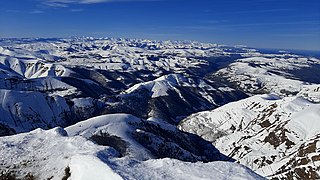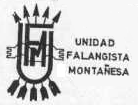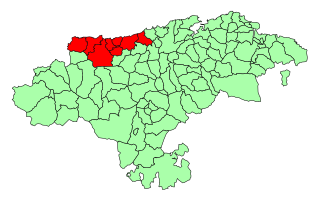
Cantabria is an autonomous community and province in northern Spain with Santander as its capital city. It is called a comunidad histórica, a historic community, in its current Statute of Autonomy. It is bordered on the east by the Basque autonomous community, on the south by Castile and León, on the west by the Principality of Asturias, and on the north by the Cantabrian Sea, which forms part of the Bay of Biscay.

In Spain, a comarca is either a traditional territorial division without any formal basis, or a group of municipalities, legally defined by an autonomous community for the purpose of providing common local government services. In English, a comarca is equivalent to a district, county, area or zone.
De la Vega is a surname in the Spanish language, most of its bearers belonging to the nobility. It means "of the meadow" and may refer to:

The Cantabrian Mountains or Cantabrian Range are one of the main systems of mountain ranges in Spain. They stretch for over 300 km (180 miles) across northern Spain, from the western limit of the Pyrenees to the Galician Massif in Galicia, along the coast of the Cantabrian Sea. Their easternmost end meets the Sistema Ibérico.
Spain has many coats of arms: the nation has one, the reigning monarch and the heir presumptive each have one, and there are others for the institutions of state and for Spanish regions and towns.

Unidad Falangista Montañesa was a Falangist political party in Cantabria, Spain. It was formed by the Provincial Junta for Promotion of Falangist Unity, a group that had broken away from FE de las JONS on July 1, 1978. UFM was registered as a political party on March 24, 1980. The founding president of UFM was Ramón Garcia-Salmones Salas.

Campoo is a comarca (district) of Cantabria (Spain) located in the High Ebro. With an area of slightly more than 1,000 km2, it includes the municipalities of Hermandad de Campoo de Suso, Campoo de Enmedio, Campoo de Yuso, Valdeolea, Valdeprado del Río, Valderredible, Reinosa, Las Rozas de Valdearroyo, Santiurde de Reinosa, Pesquera, and San Miguel de Aguayo. The local inhabitants are called Campurrians . Its highest elevation is the Cuchillón peak, and the lowest is Pesquera, with the capital, Reinosa at 850 m.

The Western Coast of Cantabria is a comarca of said Spanish autonomous community which comprises the municipalities of Val de San Vicente, San Vicente de la Barquera, Valdáliga, Comillas, Udías, Ruiloba, Alfoz de Lloredo and Santillana del Mar.

The Valleys of the Saja and Nansa Rivers comprise an administrative comarca in Cantabria, Spain. It is formed by the valleys of said rivers, each one being a natural comarca of its own.
San Mateo is a village of the municipality of the Los Corrales de Buelna in the autonomous community of Cantabria, Spain. Situated to the north and its population is 300 people.

Garci Lasso de la Vega II, also known as “El Joven” was the son of Garci Lasso de la Vega "El Viejo" with his first wife, Juana de Castañeda. He commanded Castillian troops against Navarra in the Battle of Río Salado of 1334. After distinguishing his valor, he was appointed as the highest royal official to the court of Fadrique Alfonso de Castilla, master of the Order of Santiago and son of Alfonso XI of Castile. He was later appointed Adelantado of Castile through the patronage of Juan Núñez de Lara. After the death of his patron, he sought refuge in Burgos, fearing the wrath of Juan Alfonso de Alburquerque. King Peter the Cruel and his henchmen captured him there where he suffered an atrocious death witnessed by the king in 1351, as reported by Pero López de Ayala in his chronicle on the reign of this monarch.

Garci Lasso de la Vega I, also known as "el Viejo" was a Spanish noble in the service of King Alfonso XI of Castile. He was the chancellor of the Kingdom of Castile, an adelantado of the king. He later became the chief justice of the king and gained vast properties in Asturias de Santillana and feudal land tenures and vassal towns in more than fifteen areas throughout Castile. He went to Soria in 1328 to recruit allies against infante Don Juan Manuel who had been consistently violating the king's territories. The Spanish nobles of Soria assaulted him with crossbows, driving de la Vega to seek cover at the Convent of San Francisco where he was eventually killed. Alfonso XI punished all those responsible, ordering their execution.

Garci Lasso Ruiz de la Vega was a Spanish noble from Cantabria and one of the pillars in the history of the prominent contemporary House of Garci Lasso de la Vega or Garcilasco de la Vega. As the eldest son Garci Lasso Ruiz de la Vega succeeded his father, Garci Lasso de la Vega II, as the head of his household.

Leonor Lasso de la Vega was a Spanish noble woman from Cantabria and head of the prestigious House of Lasso de la Vega from 1367 - 1432.

The House de la Vega, Laso de la Vega or Lasso de la Vega is a Spanish noble line from the Kingdom of Castile. The family origins lie in the areas now known as Torrelavega which was established in the Middle Ages. The House of de la Vega was one of the most important families in the territory, which now makes up Cantabria, and they dominated a large amount of the terrain and property between the Torre de la Vega and the Castillo de Argüeso.

Saja-Besaya Natural Park is Cantabrias largest natural park on the northern slope of the Cantabrian Mountains in West Central Cantabria, Spain. Its hunting reserve is approximately 1800km², the largest and most important in Spain.

Suances is a municipality in Cantabria Province, Spain.

Asturias de Santillana is a historical comarca whose territory in large part corresponded to the central and western part of today's autonomous community of Cantabria, as well as the extreme east of Asturias. Most of the province of Asturias belonged to the comarca of Asturias de Oviedo. Also known also as a merindad and documented since the 13th century, Asturias de Santillana comprised the western part of Cantabria including the Saja River valley and the Nansa River. Its borders used to go along the coast from the council of Ribadedeva to the municipality of El Astillero, to the shores of the Bay of Santander), which leads to the administrative division of Trasmiera. From the south it went up to the Cantabrian cordillera. All of the valleys of this comarca are perpendicular to the coast.

The Nine Valleys lawsuit or simply Valleys lawsuit was a process that confronted the Nine Valleys of the Asturias de Santillana with the Dukedom of the Infantado. Begun in 1544 and it was ruled in 1581 in favor of the Nine Valleys. Its importance was capital in the process of the territorial configuration of Cantabria, since he achieved the independence of the valleys, constituted in the province of the Nine Valleys in 1589, germ in turn of the province of Cantabria of 1778, and caused the retreat of the manorial domains in the region. His memorial occupies 178 folios.

Viveda is a Lugar of the municipality of Santillana del Mar. It borders the towns of Barreda, Queveda and Camplengo, and Hinojedo. It is located 4 km from the municipal capital, Santillana del Mar, 3 km from the nearest city, Torrelavega, and about 22 km from Santander, Spain.




















